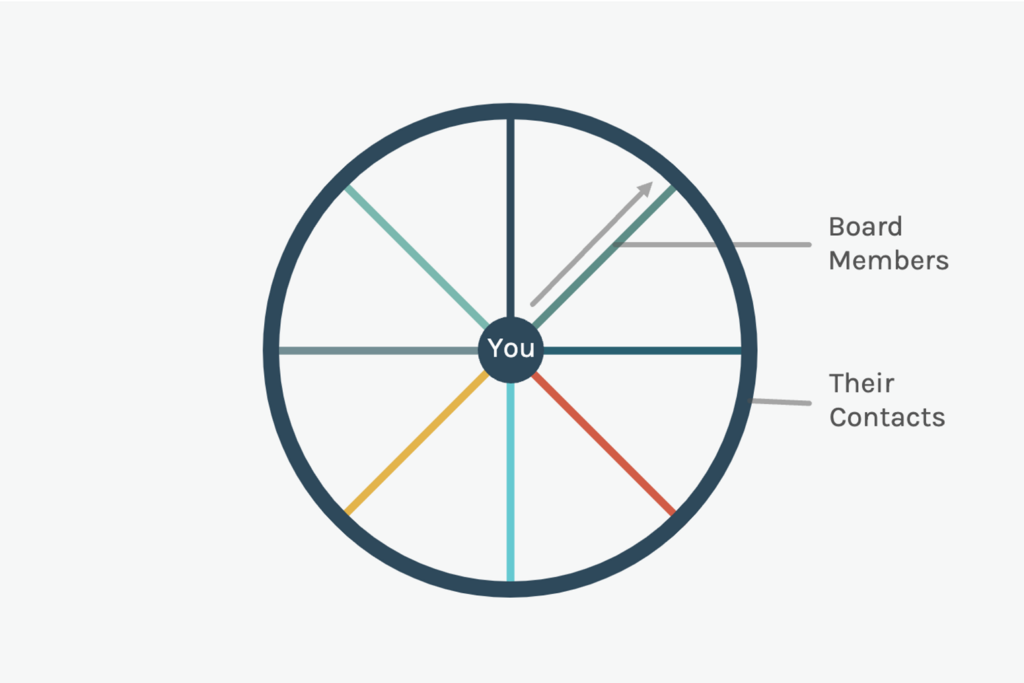The fundamental pillars of all successful fundraising efforts include a compelling case, strong governance, a comprehensive plan, and a robust donor pipeline. But what happens when you have worked your way through your pipeline and still need new ways to uncover new donor prospects? The easiest connections to make are existing ones, and leveraging these relationships to reinvigorate your prospect pipeline can be a game changer.
Finding New Donors for Your Nonprofit
A prospect list review session, sometimes called relationship mapping, is common among nonprofits as an effective and efficient method of enhancing your pipeline. Pretend that each of your board members is one of many wheel spokes, branching out from the middle and serving as connectors between the center and the outer rim. Who are they connecting to the center of the wheel?

With some strategic planning and forethought, you can leverage your board’s contacts and networks and develop paths to individuals who can make a difference for your organization.
how one nonprofit leveraged its board
A New York City performing arts organization struggled to uncover new donor prospects, and their prominent, well-connected board members constantly offered to introduce their networks. To capitalize on these introduction offers, CCS Fundraising assisted the organization in developing a strategic plan to engage individual board members, leverage their networks, and uncover new prospects, which included the following:
1. Peer Board Prospect Research
Six weeks before the next board meeting, the organization’s development team compiled a list of every peer nonprofit board where a member of their own board also held a seat. They compiled a streamlined list from this group of more than 30 organizations, noting the name and title of every other board member of the peer organizations. They identified more than 500 names, compiled the lists into booklets, and distributed them at the upcoming board meeting.
2. Prospect Name Review
Each board member received their booklet during the board meeting’s list review section. CCS and the Head of Development led the board through reviewing the names on each page. Board members indicated the people with whom they were willing to facilitate an introduction by checking a box next to each name. Development staff also attended to help capture information, ensuring the notation of all connections, with the booklets collected at the meeting’s end.
3. Developing Donor Relationship Strategies
Following the meeting, development staff collated the lists and created individual profiles for each identified connection, noting corporate information, philanthropic interests, and history. Staff scheduled one-on-one meetings with board members to develop strategies to engage and cultivate new prospects. For example, one board member noted their interest in connecting to eight new prospects. Staff developed cultivation plans for these eight prospects, which included an invitation to an upcoming musical performance and a private tour of the facilities where a meet-and-greet would occur backstage. For other prospects, cultivation plans included an introductory breakfast for the prospect to meet the senior leadership and opportunities to learn more about educational events at the organization.
Leveraging Your Board’s Network uncovers new donor prospects and Deepens Existing Relationships
Though this process required extensive time and effort from the development team and the board’s commitment and support, it resulted in more than 80 newly identified connections. Of these connections, staff invited more than half to a general cultivation event, and the remainder received tailored engagement plans. Board members felt they had provided an invaluable resource, which helped deepen the working relationship between the board and the development team.
YOUR BOARD CAN BE AN ONGOING PROSPECT RESOURCE
Your organization should build regular prospecting and list review sessions into its daily culture. Early and often, engage board members in deliberate conversations about potential prospects within their networks and circles. Ask your board to facilitate introductions, an effective way to mitigate potential hesitancy around not wanting to “ask friends for money.” Finally, create a regular calendar of list review sessions for each board meeting. Provide board members with relevant and targeted prospect lists that include peer nonprofit boards, for-profit and corporate boards, foundation boards, university alums, and aspirational donors.
Your board members are already passionate about your cause, and leveraging their personal networks to uncover new donor prospects will deepen their engagement—and further your mission in the process.
More Insights
5 Tips to Turn Volunteers into Donors
Volunteers can become invaluable donors with the right approach. Read our article to learn how to leverage these relationships.
RFM and Wealth Screening for Major Gift Strategy
Learn how to perform an RFM analysis, the simplest tool to start narrowing your prospect list to your most impactful donors. This article contains background information and a video to lead you step-by-step into meaningful engagement.